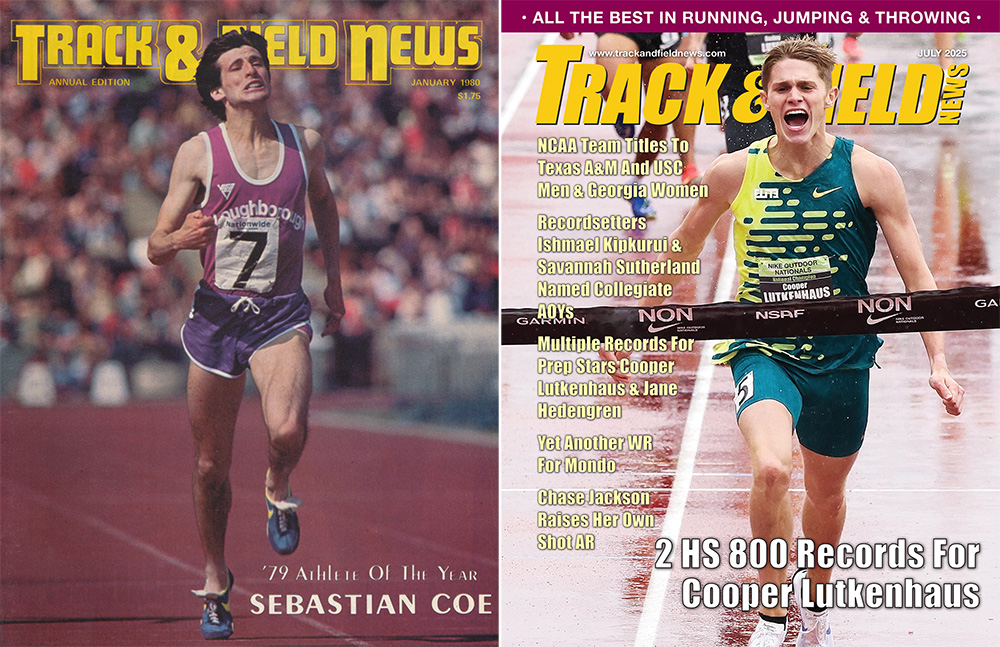“The only way I can explain this new record is that everything went well,” said Seb Coe on the night he ran 1:42.33, history’s first sub-1:43. Cooper Lutkenhaus, now a 1:42 guy at 16, can probably relate.
THE TRACK SHOCK of the summer so far, it is safe to say — certainly for dyed-in-the-wool U.S. fans — has been 16-year-old Cooper Lutkenhaus and his sledgehammering of the 800’s High School Record: 1:46.26 and then 1:45.45 in June. That was just the start.
As August began, the prep soph from Texas exploded past 1:44 and 1:43 all the way to 1:42.27 in placing 2nd to ’19 world champion Donavan Brazier in the USATF Champs final.
Is your head still spinning?
You’re far from alone. Thus who better to poll for some perspective, we thought when the opportunity arose, than the first 800 man in history to race under the 1:43.00 barrier and — 23 months later — into 1:41 territory.
That man, of course, is World Athletics President Seb Coe. In this millennium, Briton Coe, now 68, makes news leading the charge for our sport globally and as a heavyweight in international sports governance and business generally.
Yet in another life, as it were, 46 years ago in Oslo, Norway, Coe, then 22, chopped down the 800 World Record by a full second. (PremiumT&FN subscribers can view the race report in the September ’79 issue linked from our Past Issues page)
His July 05, 1979 race to 1:42.33 smashed a standard set 2 years earlier by Cuban Olympic legend Alberto Juantorena. Another two years later in June of 1981 — having won the first of his two Olympic 1500 golds in the interim — Coe blasted the WR down to 1:41.73. That record defied challenge for 16 seasons until Kenyan-born Dane Wilson Kipketer at long last dispatched it with a 1:41.24 run in 1997.
The World Record has since progressed to 1:40.91, a product of David Rudisha’s otherworldly 2012 London Olympics victory. Coe, we need not mention, shepherded that Games to its colossal fruition as CEO of its local organizing committee.
Seb Coe knows the 2-lap event, so we asked him about Lutkenhaus and his record, which is not just a U.S. HSR but the World Youth (U18) Record, as well.
Coe: “Well, first of all, I’d measure the track. By the way, that was a joke. My Comms team are looking at that track.
“No, I’m teasing you. I mean, somebody told me [about Lutkenhaus’s time] when I was in my office in Monaco, and I thought, ‘No,’ I said. ‘You’ve got that wrong.’
“You know, this has got to be a typo. And they said, ‘No, no, no.’ And it was — yeah, it’s extraordinary.
“Look, it’s happening in a lot of sports at the moment. As you know, I’m a bit of a football addict. I watched a couple of games this weekend in Monaco while I was preparing for Tokyo. I watched two Premier League sides playing two 15- and 16-year-old kids. And one of them made such an impact they won the game in the dying embers for Liverpool.
“So, I think we just have to accept the fact that you’ve got some outstanding talent. They’re coming through younger than they probably have in the past.
“That’s probably a testament to good quality coaching.”
Coe then added “one word of caution, and that is that any coach will tell you that the biggest challenge and the highest attritional rate in our sport is often from 16–17 through to the Senior ranks.
“Good coaches are paid and earn every penny of their money in steering a top class Junior or even Youth athlete into the Senior ranks. The sobering stat that we’ve always looked at is that the majority of athletes that even win medals at World Junior Championships don’t make it into the Senior team, their Senior national team, 2, 3 years later. That’s a very high level of attrition.
“So the handling of those athletes, when they show such prodigious talent at such an unexpected age — you can sit back and celebrate. But actually that poses some really big challenges for the coaching structure, even sometimes parental caring networks around them to make sure that that journey is done carefully.”
The crucial aim of development, Coe added, is to make sure “you don’t lose so you’ve got the same progression for the next 5 or 6 years and it’s not something, you know, at the age of 40 they’re going to look back at and say, ‘Well, you know, I was great for a season.’
“That is the challenge. But [Lutkenhaus’s record] is an outstanding performance. It clearly is an outstanding performance.”
Lutkenhaus in late August signed a full professional contract with Nike — upgrading from his prep NIL relationship with the shoe and apparel giant as he leaves prep competition behind. As the most markedly precocious American schoolboy middle distance runner since Jim Ryun 6 decades ago forges his path at the sport’s elite level, he and his well-established support team — family, coaches and friends — will be well advised to keep Seb Coe’s observations front of mind.
Next stop: Tokyo.
Sieg Lindstrom is Track & Field News‘s Editor. He fell in love with the sport as a high school distance runner, and has covered 9 editions of the Olympics and 16 outdoor World Championships. In a feverish effort to brush up his résumé before he was hired, he also attended the ’84 Olympics and ’87 Worlds as a fan.
Post navigation
Discover more from 6up.net
Subscribe to get the latest posts sent to your email.


